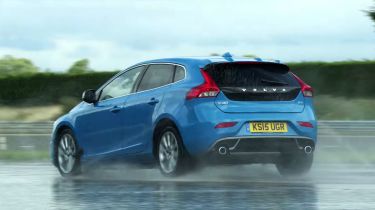Stopping distances explained
Stopping distances are part of what defines how fast it’s safe to travel. We reveal all about one of the Highway Code’s most famous rules

What is a stopping distance?
In essence, a stopping distance is how far a car takes to stop from a specific speed. There are various different variables that affect it, including the condition of your car’s tyres and brakes, the condition of the road surface, the prevailing weather conditions and your level of attention. All of these are significant factors in determining how soon your car will come to a halt.
Stopping distances consist of both the distance travelled during the time it takes to react, known as ‘thinking distance’, and the distance travelled while doing the braking itself, known as ‘braking distance’. According to the Highway Code, you’ll travel 21 metres at 70mph just thinking about braking, a distance that equates to the length of four Range Rovers. And, by the time you’ve managed to bring your car to a standstill, you’ll have travelled the length of a football pitch.
With road rage and tailgating seen as increasingly prevalent on our roads, it’s worth remembering to keep a safe distance from the car in front. Note that your stopping distance doesn’t increase in a linear fashion as your speed goes up – it actually increases exponentially, as the table below highlights.
| MPH | Thinking (m) | Braking (m) | Total (m) | Car lengths |
| 20 | 6 | 6 | 12 | 3 |
| 30 | 9 | 14 | 23 | 6 |
| 40 | 12 | 24 | 36 | 9 |
| 50 | 15 | 38 | 53 | 13 |
| 60 | 18 | 55 | 73 | 18 |
| 70 | 21 | 75 | 96 | 24 |
How can I remember stopping distances easily?
Simply increase the multiplier by 0.5 for every extra 10mph you’re going. So at 20mph, the stopping distance is around 40 feet (2x 20mph = 40 feet).At 30mph, the stopping distance is around 75 feet (2.5x 30mph = 75 feet). Multiplying 40mph by 3 and 50mph by 3.5 produces the stopping distances in feet for those speeds.
The two-second rule
Another way to think about braking distances is to stick to the ‘two-second rule’. This is where you pick a point in the distance being passed by the car in front of you, which is going at the same speed, and you distance your car so that you pass the same point no sooner than two seconds afterwards. To help you achieve this, saying ‘only a fool breaks the two-second rule’ will handily take roughly two seconds.
Bear in mind, too, that stopping distances will effectively double when it’s wet, and treble when it’s icy, so you’ll need to say the rhyme up to three times in these circumstances.
 Driving in snow and ice: top winter driving tips
Driving in snow and ice: top winter driving tips
What other things affect stopping distances?
How alert you are plays a pivotal role in your braking distance. Drugs, alcohol and general fatigue seriously increase your thinking or reaction time, extending your braking distance. Taking a hands-free phone call or dealing with a noisy child can affect your concentration and reaction times, too.
Cold temperatures can affect your tyres’ braking performance while driving in the dark or fog can severely hamper visibility and hence your reaction times.
How important are tyres to braking?
Because they’re the only part of the car that’s in contact with the road, tyres are a hugely important factor in your braking distance. Legally, they should have at least 1.6mm of tread, but we advise not going below 3mm. Tyre pressures should be checked at least once a month, too, to ensure your tyres are performing at their best.
How does rain affect braking distance?
Generally speaking, your braking distance will double in the rain, so at 20mph it’ll take 24 metres to stop, while at 70mph, it’ll take closer to 200 metres.
How does alcohol affect braking distance?
The best advice is not to drink at all, since not only will your reaction times suffer, you also won’t press the brake pedal as hard as you would when stone-cold sober.
For more driving tips, why not read our guide to safe motorway driving.
Most Popular

New Smart #5 Brabus is a 637bhp far cry from the brand’s city car past

Best car leasing deals 2025: this week’s top PCH offers
Tips & advice

Car dashboard warning lights: what does each symbol mean?

Electric car charging stations: public networks, charger types, apps and maps








